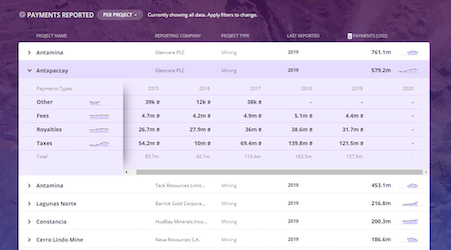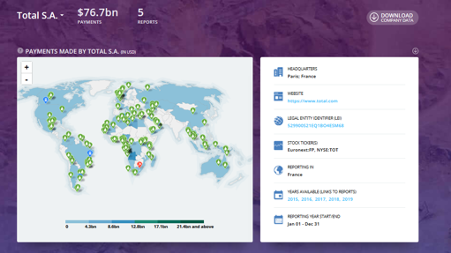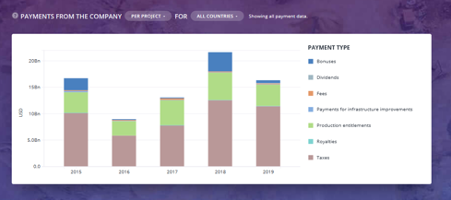
Upgraded ResourceProjects.org Offers Robust Data on Extractive Companies’ Payments to Governments
My colleagues and I are excited to announce a major update to ResourceProjects.org, our open data portal for oil, gas and mining company payments to governments.
Since 2017, ResourceProjects.org has been the only place to find all the project-level payments to governments data disclosed by oil, gas and mining companies around the globe. Now, with just-released improvements, it’s easier to find, track and analyze data critical for accountability in natural resource extraction.
The site currently hosts data from over 900 companies, most with three or more years of consecutive disclosures. Regulations in the European Union, the United Kingdom, Canada and Norway require natural resource extraction companies to disclose how much they pay to governments. The regulations apply to companies registered in or listed on stock exchanges in those jurisdictions, and cover any payments made to governments over $100,000.
Companies reporting payments include European supermajors BP plc, Royal Dutch Shell plc, Total SA and Eni s.p.a.; state-owned oil and gas giants Equinor ASA, CNOOC Limited, Gazprom and Rosneft; and mining majors Glencore plc, Rio Tinto Plc, and BHP, plus hundreds more.
So what’s new?
With a new data layout and updated company and country pages, you can quickly find out how much (or little) a company is paying in taxes, royalties, production entitlements and more on a mine or oil block, and to which specific government entities.
Across all the payment tables on ResourceProjects.org, data is now grouped across years so you can easily see how payments on a specific project or to a government entity have evolved across all reported years. By clicking on a row to expand it you will see the breakdown by payment types.
Viewing project-level payment data in Peru
We have also updated our country and company profile pages to bring the most relevant data upfront. On country profiles, you’ll see an overview of what data has been disclosed in that country: number of projects by type; number of government entities at the national, regional and local level; and amount reported in the most recent year. You’ll also see the locations of reported projects (locations are based on NRGI research; not all reported projects can be identified).
Company profile pages remain a central feature of ResourceProjects.org, where you can go to find the whole-company picture of a company’s payments to governments. At the top, you’ll find information on the company itself, including its headquarters, stock tickers (if applicable), what country it’s reporting in and links to its original payments to governments reports.
Just below, we’ve added a data visualization to show the total amounts companies have reported in payments to governments across all years by payment type; you can use the dropdown to select a specific country.
And at the bottom, you’ll see all the payment data grouped by project or government entity, with filters to select specific projects, countries or payment types for comparison. Expand the rows by clicking to view all the data disclosed on that project or to the government entity.
Timely data for accountability
We update ResourceProjects.org every week with new reports as soon as they are published, with all data standardized across currencies and reporting formats so you can compare payments from different companies and years; many companies have three or four years of data to analyze. I hope you’ll take a look at the new and improved ResourceProjects.org and check back often. Get in touch with me with any questions or comments at tmorrison@resourcegovernance.org.
Tommy Morrison is research and data officer at the Natural Resource Governance Institute (NRGI).





